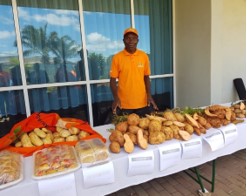Speeches Shim
Viable Sweet Potato Technologies in Africa (VISTA) ![]() (pdf - 157k)
(pdf - 157k)
BACKGROUND
While Mozambique’s economy has had consistent growth rates for several years, progress has been much slower in rural areas. Food insecurity in these rural areas remains a significant challenge. At least 25% of the rural population consistently suffers from food insecurity, 43% of children under the age of five suffer from chronic malnutrition (stunting), and more than 65% of children under five have deficiencies of essential micronutrients, such as vitamin A – which compromises the immune system and can lead to blindness. Moreover, continuing drought conditions in much of the country have put an estimated 1.5 million people in a position of acute food insecurity, including more than 86,000 pregnant or lactating women. An estimated 191,000 children under 5 years old became acutely malnourished in 2016 alone. A comprehensive response that combines interventions from a range of agricultural, economic, health, and social service sectors is required to address this rural poverty and malnutrition challenge.
PROGRAM DESCRIPTION
The overall goal of Viable Sweet Potato Technologies in Africa (VISTA) is to improve nutrition, food security, and incomes of beneficiary households through increased production and use of nutritious orange-fleshed sweet potato (OFSP) varieties. Beneficiary households are defined as those with children under five years of age, and pregnant and lactating women. VISTA focuses on three areas: agriculture, nutrition, and marketing. Agriculture activities in targeted districts start with farmer-led “mother baby trial designs,” which serve to identify preferred varieties of sweet potato. The preferred varieties are then distributed to beneficiary households via voucher and selling plans. VISTA also improves nutrition education, hygiene practices, and aims to diversify the household diets through implementing community-level nutrition education and behavioral change sessions for principal caregivers (both women and men). Having women participate in these sessions is critical for achieving adoption of new dietary practices and the effective preparation of sweet potato as a weaning food. To improve marketing for OFSP varieties, VISTA links farmers to markets and traders, and informs consumers about where to purchase OFSP.
EXPECTED RESULTS
By the end of 2021, at least 102,500 direct and 375,000 indirect beneficiaries (those who have gained knowledge and skills through farmer-to-farmer communication) will have improved access to clean OFSP planting material and related technologies. Almost 10,000 households will have increased their incomes from the sales of OFSP roots in local and urban markets, including fresh root and leaf markets.
Results as of the end of the 2015/16 cropping season:
- Almost 324 hectares (baseline at 29 ha) were established with improved OFSP planting material in four districts in Nampula and two in Zambézia
- 21,542 direct beneficiaries (48% female) were reached with clean OFSP planting material and related technologies
- 21,620 individuals (51% female) received short-term agriculture productivity trainings, including 26 Extension Agents and 15 people from the civil society
- 196 people and professionals were trained in child health and nutrition
- 25,360 children under five (60% female) were reached by nutrition-specific interventions
- From a baseline of USD19,045, the value of small-holder incremental sales generated by the trading of OFSP increased to nearly USD79,000 during 2014-16.


Comment
Make a general inquiry or suggest an improvement.